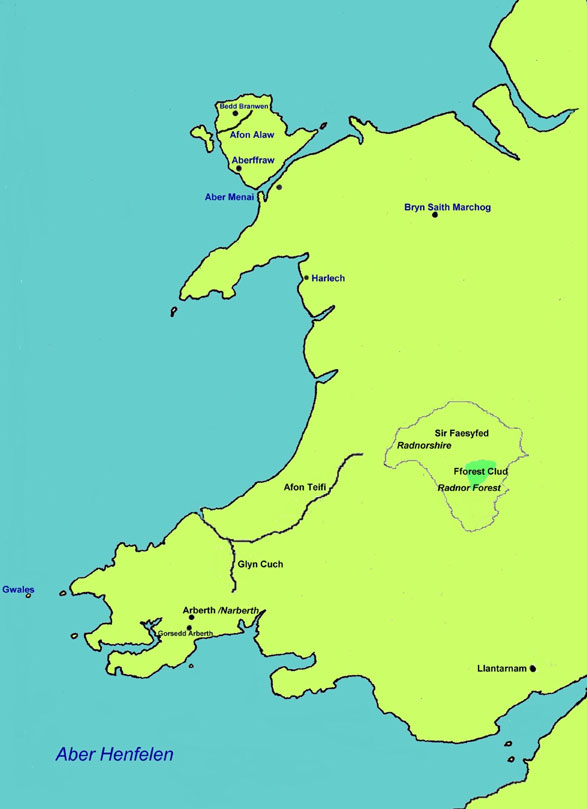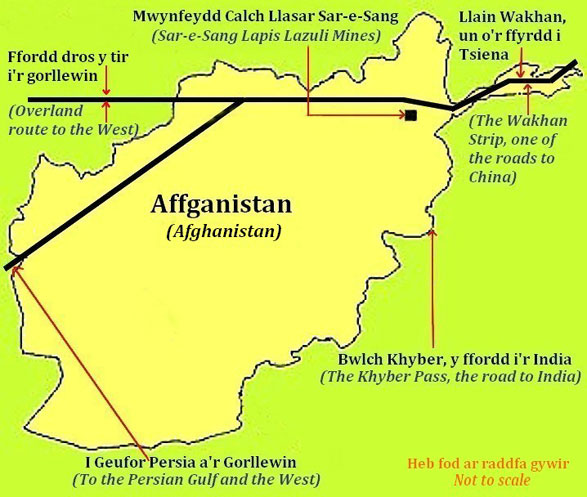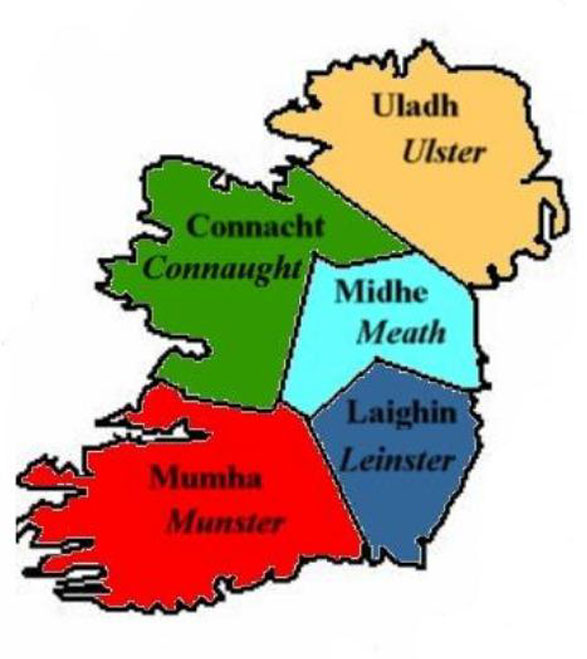Introduction
to the Second Branch
The following pages do not contain the whole of the tale. You must have a copy
of the Mabinogi (unabridged if possible, but it does
not matter which version) and any modern Ordnance Survey
maps of the areas under consideration. But remember
that the book was originally written in Middle Welsh,
so the spellings are likely to vary between each
version
according to the editor's choice.
Branches 1, 2 & 3 of the Mabinogi do not contain as many place-names as the 4th branch which
was largely set in Gwynedd. But this does not mean
that the writers were less familiar with places outside
Gwynedd. Words, idioms and pronunciation by writers
who were obviously from South Wales characterize the
whole work. After all, it was not the chief purpose
of the story-tellers and later, scribes to give a detailed
geographical description of Wales Of Old: the story
itself was all.
The Four Branches of the Mabinogion form a complete work, not four separate parts.
Only one character, Pryderi, appears in all four parts.
The stories appear disconnected at times because, according
to many scholars, some connecting tales have been lost
over the centuries, but one theme connects the whole
work – the life of Pryderi.
Yet it is possible to find additional information about places by looking closely
at personal names. Sometimes some of the names appear
to be unreal, perhaps the correct ones having been
forgotten over the centuries. Therefore it is likely
that the names were created to contain some of the
attributes and origins of the character: e.g. Pwyll
and Pryderi (“Sense” and “Concern”)
As with the fourth branch, we must bear in mind the nature of mediaeval society
and its attitude to ages past. Often, its recent, as
well as ancient, history is mingled with traditions
which are likely to have had their origins in prehistoric
times.
Viewing the Locations
Any modern Ordnance Survey maps of the areas under consideration are suitable.
But the best way to see them all free on your screen
is to open a separate page and go to -
http://getamap.ordnancesurvey.co.uk/getamap/frames.htm 
Copy the O.S. map reference (e.g. SH581312) into the search box on the left.
The Second Branch
‘Bendigeidfran, son of Llyr was the crowned king of This Island (The Island of
the Mighty – Britain) and possessor of the crown of
London.’
Bendigeidfran and Branwen
(Bran “the Blessed” and Bran “the Pure/Holy”)
Bran, in the case of these names, means “raven” –
a bird sacred to the Ancient Celts., But in general
use
it means “crow”, a name for several types of very
common birds - which could therefore appear in any
number
of place-names without relating to the hero Bran
and his sister.
Yet it is possible that the personal name Bran occurs
in many place-names possibly reflecting how widespread
the ancient religious cult was, but without having
any particular link to this story.
Harlech (O.S. SH581312)
Harddlech – ‘The beautiful
stone’. Location of Bendigeidfran’s castle.
This is the rock upon which the present castle was
built in 1283. It was beside the sea during the Middle-Ages.
But since then the sea has retreated and now it is
almost a mile away.
London
Here is the first direct
mention in the Mabinogion of somewhere outside Wales,
and it is there to reflect
how important London had become as the seat of
power by the time the Mabinogion was written down. Ardudwy
»» A map showing the Main Divisions of Wales in the Middle Ages   (249kb) (249kb)
Ireland
A collection of small
kingdoms ruled over by clan leaders who paid allegiance
(sometimes!) to the
High King of
Ireland.
Matholwch
Perhaps he was one of
the numerous clan leaders - there is nobody of this
name in the long lists of
the High
Kings of Ireland. See - www.heraldry.ws/info/article12.html 
Aberffraw (O.S. SH355689)
One of the courts of the Princes of Gwynedd in the Middle Ages.

Tal Ebolion
(Cantref) »» A map showing the Main Divisions of Wales in the Middle Ages   (249kb) (249kb)
This is an onomastic story
- “The End of the Ridges” is a possible meaning
rather than anything to do with horses.
In those
days, marriage to foreigners was generally disapproved
of in both of the countries, and perhaps
by Efnisien in particular. He objected to the
marriage because he had not been consulted about it.
As
in “The Life of St Cadog”, the thieves' horses were
mutilated (to draw attention to the criminals
wherever
they went) - therefore Matholwch was compared
to a thief. Because of Efnisien’s actions,
the Irish
were
given the Cauldron of Rebirth (Y Pair Dadeni)
in compensation. In the first place, Llasar
Llaes Gyfnewid (see below)
gave this magic cauldron to Bendigeidfran.
Llyn y Pair
Somewhere in Ireland,
according to the Mabinogion.
Although examples of the
name Llyn y Pair are to be seen in Wales, they have
other explanations.
Here are
two examples.
- In “Branwen, Daughter
of Llyr” (p.38) Proinsias Mac Cana wrote:
“According to William Owen Pughe (1759 -1835), there
was a lake called Llyn Pair about 3 miles from Towyn,
(near Aberdyfi, more than likely) and the nearby
river, called Gwenwyn Meirch Gwyddno (the poison
of the horses
of Gwyddno) in the story of Taliesin, was at the
time of writing known as Avon Llyn y Pair.”
This certainly refers to the Cauldron of Ceridwen.
- On
the edge of Gwydr Forest near Betws y Coed, the Melin
Llyn y Pair Mine
is located.
The word ‘Pair’, in this instance refers to a smelting
vessel used by lead & copper
miners.
The Irish in Wales
According
to Charles Thomas, a family of Irish descent ruled
in Dyfed until the 8th century. (See www.islandguide.co.uk/history/ogham.htm  ) )
Accounts of Irish attacks
are found in the manuscripts of Ammianus Marcellinus
which began in the period
360 - 367. But some were given leave to stay
by the Romans. Llasar Llaes Gyfnewid
and his wife Cymidei Cymeinfoll
It is possible that the
name Llasar originated in the Irish word “lassar” (flame),
and the Welsh word “cyfnewid” (exchange) may perhaps
indicate he was a merchant of some sort.
They escaped
from the Iron House somewhere in Ireland and moved
to Wales with Bran’s permission. Their son was one
of the Seven Knights. They were Irish, but certainly,
Bendigeidfran trusted them. But the name Llasar is also very similar to the Welsh
“llasar” (a very expensive blue stone) which came
from the Persian word lājward, through the Arabic
lāzaward. It is known best in English through its
Latin name lapis lazuli, or as azure from the French
word azur.
Mining began in Sar-e-Sang
over 6,000 years ago in the limestone of the Kokcha
Valley, (Badakhshan Province 38°0´ N 71°0´ E, Northeastern
Afghanistan). For centuries lapis lazuli was used in
the Middle East, Far East and Egypt (e.g. examples
were found in the tomb of Tutankhamun) but Alexander
the Great (356 –323cc) was the first to send examples
of it back to Europe. The location of the mines was
kept secret for thousands of years. The stones would
change hands up to fifty times, even before reaching
Europe.

»» See 'Places mentioned in the Third Branch of the Mabinogi'  Cymidei Cymeinfoll
Her name seems to be made
up in order to describe her as “mother of an army”. Aber Menai (O.S. SH440610)
Caer Saint (O.S. SH477627)
Although
the old storytellers would have referred to the
old Roman settlement of Segontium, those who wrote
down
the tale would have been very aware of the castle
and town of Caernarfon (about one kilometre away)
built by Edward 1st. to oppress the Welsh. But ironically,
Caernarfon is now, by language, the most Welsh
town
in Wales. Edeirnion
»» A map showing the Main Divisions of Wales in the Middle Ages   (249kb) (249kb)
Bryn Seith Marchawg (O.S. SJ076502)
Bryn Saith Marchog – a
small village in Denbighshire (Cantref Edeirnion) This
is another onomastic story.
According to Ivor Williams, “seith/saith” could
sometimes mean “saint” in Middle Welsh rather than
the number
“seven”; and perhaps “marchog” (knight) refers
to the previous military career of someone like Saint
Derfel, Saint Sadwrn etc.
Two Rivers
Where the Irish Sea is
now.
According
to the University of Wales Dictionary,
Lli = 1. like a blade or -
2. A deluge, flood.
Archan = “Supplication” 
During the Mesolithic Era (about 7,500BC - after the
last Ice Age), the massive glaciers melted and Ireland
and Britain were separated. In the following millennium,
the sea-level rose very rapidly, separating Britain
from the Continent. Perhaps, at some stage, there were
two channels as the sea retreated.
In Wales we have
the legends of ‘Cantref y Gwaelod’ (The Lowland
Hundred) in Cardigan Bay; Llys Helig near
the Great Orme etc. [See also the legends of Lyonesse
between the Scilly Isles and Cornwall; Ker Ys, off
the southern coast of Britanny; and of course Atlantis
somewhere in the world of the Ancient Greeks etc.] But in particular, the North Channel between Ireland and Scotland was exceptionally
narrow.
There is an Irish tale of the giants Fionn mac Cumhail (Finn Mac Cool) and
Benandonner crossing the sea between Northern Ireland and Scotland with ease.
Was it an old, old folk memory among the Strathclyde Welsh also?
Afon Llinon
(in Ireland)
River Shannon or River Liffey?
- Matholwch’s army
retreated to the west, across the River Shannon which
formed
most of the boundary between
Connacht and two other provinces; Meath and Munster.
The largest river in Ireland is deep and a good
defensive line.
but
- The River Liffey formed
a short part of the border between Meath and Leinster
in the Dublin area. (O 174 353 Irish Grid) It is interesting
to note the City’s Irish name Baile Átha Cliath (town
of the hurdle ford), because in the Second Branch of
the Mabinogion, hurdles were placed across Bendigeidfran’s
back so that the army could cross the river -another
onomastic story. Perhaps the rivers were mixed up -
remembering that the Mediaeval Welsh were likely to
be more familiar with Dublin than with Connacht.
Aber
Alaw in Talebolion (O.S. SH301814)
Click here to see the map
This is where the seven
survivors of the war landed on their return to Wales.
Glan
Alaw (Branwen’s Grave) (O.S. SH361850)
A Bronze Age burial
site. The grave goods can be seen in Bangor Museum
or go to: http://www.flickr.com/photos/bobbielise/3698468949/ 
Gwales
(O.S. SM598093)
21 acre island, 10 miles
from the coast of Pembrokeshire. Grassholme is the
name which
was given to it by the Vikings who would use the
island as a base from which to launch their raids
on the British Coast. No-one yet has found remains
of “a great hall”. Some see a direct connection
between themes in the Second Branch and those of the
Icelandic
Sagas.
(in the University of
Wales Dictionary, Gwales = hiding place, refuge)
Where
is Llychlyn?
Although there is no direct
mention of Llychlyn in the Mabinogion, here are some
examples
to show how
confusing even the names of countries can be.
Llychlyn
in modern Welsh and Lochlann in modern Irish is Scandinavia,
Norway especially. (The name Lachlan
and other Scottish and Irish names similar to it
were originally given to descendants of the Vikings.)
Although, in the Welsh Triads, Macsen Wledig (Magnus
Maximus in Latin) mounted an attack on Llychlyn,
according to contemporary Roman documents, the same
man went towards Rome with his army in 383. Rachel
Bromwich listed examples of mistakes such as this
- she suggested that Llydaw (Brittany) was more likely,
since it is at least in the right direction.
It would have been easy for people without any reliable
geographical knowledge to fail to differentiate between
their enemies - they were all as dangerous as the Vikings.
And in the centuries which
followed, more raiders came from Ireland to Wales.
They were not of Irish stock but Vikings who had by
then settled there, mostly in Dublin and other seaports.
To the Welsh of the Middle Ages, they were all by then
Irish!
Cornwall
A Celtic country, like
Wales. (See the First Branch  ) ) Aber Henfelen
The Bristol
Channel
The White Hill (O.S.
TQ336805)
(In London) – where
the Tower of London now stands. In
this context once again, “white” implies “holy” in
Welsh rather than the colour.
Caswallon
Cassivellaunus in Latin. King of the Catuvellauni (in South-east
England now) who successfully resisted the second
invasion
of Julius Caesar in 54 B.C. (The Romans accused Caswallon
of helping rebels in the Province of Gaul – but they
were also very keen to have all the wealth of Britain.
As the most powerful leader in Britain, Caswallon
had many opponents on this island, especially those
who
lived far away from the south-east. In spite of this,
the Romans only received scant support from the other
tribes.)
The name is mentioned
in the 3rd Branch, in Lludd and Llefelys and in a
number of the Welsh Triads.
According
to some, the name in the Triads refers to a now-lost
mediaeval romance, possibly about a different individual
of the same name.
The
Five Provinces of Ireland
Connacht / Connaught,
Midhe / Meath, Laighin / Leinster, Mumha / Munster & Uladh / Ulster. (See map below)

Nowadays there are four provinces - Laighin / Leinster now incorporates Midhe
/ Meath.
IMPORTANT DISCLAIMER: THIS LOCALITY INFORMATION IS FOR REFERENCE PURPOSES ONLY.
UNLESS THERE IS A PUBLIC RIGHT OF WAY, YOU SHOULD NOT
ATTEMPT TO VISIT ANY SITES LISTED WITHOUT THE PERMISSION
OF THE LAND HOLDERS.
|